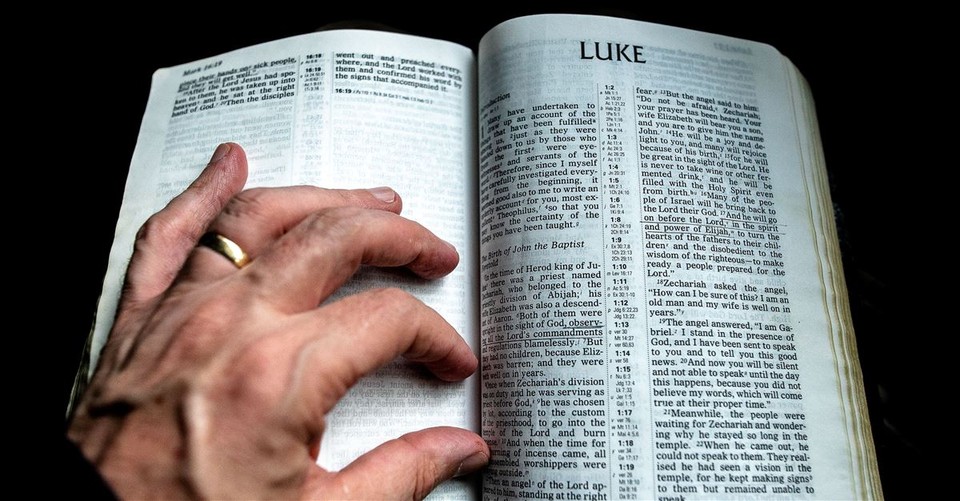What Are the Synoptic Gospels and Are They Contradictory?

The four gospels, neatly nestled in the beginning pages of the New Testament, are treasure troves of instruction regarding the person of Jesus Christ. Within these four individual accounts, the reader meets Jesus as the fulfillment of the Old Testament prophecies, an authoritative teacher, and our redeemer. We are provided with the narrative for his life and ministry, his death and resurrection. As our salvation depends upon the truth of the gospel message found within these four books, and our life is to be patterned after that of Jesus, the reliability and interpretation of the gospels is imperative to our faith.
Matthew, Mark, and Luke, or the Synoptic Gospels, differ from John in that they closely mirror one another in their accounts. In these three gospels, we find similar wording, chronology, and Old Testament referencing. While we should expect consistent narratives amongst all the gospels, the similarities amongst the Synoptics seem to suggest that they were written in reliance upon one another or an outside source. Even amidst the similarities, we do still find content that is unique to one or two books.
Do these similarities discredit the authors or challenge the authority of their writings? Can we trust the Synoptic Gospels? Consider these questions as we seek to understand the authority of the gospels.
Who wrote the Synoptic Gospels?
The Gospel of Matthew, one of two gospels written by a disciple, tailored its account for a Jewish audience. Matthew wrote to identify Christ as the fulfillment of the Old Testament prophecies so that the Jews would recognize Jesus as the Messiah they had long awaited.
In contrast, the Gospel of Mark is written with a Gentile audience in mind. The shortest of the four gospels, early Church history tells us that Mark had a close connection to the apostle Peter. Mark weaves a narrative that identifies Jesus as the Son of God (Mark 1:1) and demonstrates the veracity of the cross.
The Gospel of Luke is written to a specific person, Theophilus, and mounts a defense of the gospel message as revealed in the life of Christ. Though not an eyewitness to the life of Jesus, Luke wrote as a historian who had access to multiple accounts and brought them together in one narrative.
The Gospel of John, the second of the gospels written by a disciple, was transcribed later than the others and has a more universal audience in mind. John’s Gospel clarifies many theological truths in broadening the reach of the Synoptics.
Why is there more than one gospel?
While each of the gospels are united in their purpose to record the life of Jesus and the corresponding gospel message, each author takes a slightly different tack. Matthew, Mark, Luke, and John each had a different audience in mind and customize their writing for that group. Each man had a different perspective and shares the gospel message from his vantage point.
Even in light of their differences, we do know that each considered their message to be of the utmost importance. They understood that they bore a great responsibility to accurately record historical events and impart to their audience corresponding theological truths. They were not just writing to reform the lifestyle of their audience. Their job was far bigger and longer than that which affects an ordinary lifespan. The gospel writers communicated eternal truths to people who had eternal value.
When we consider the gospel writers’ need to be accurate, it makes sense that they may use another account as a roadmap for their own. If there was already an authoritative account in circulation, that document would be consulted in future writing about the same events and truths.
Many theories exist today to explain what has become known as the Synoptic Problem, or the remarkable similarities between the Synoptic Gospels. A dominant theory, Markan Priority, suggests that Mark was written first, followed by the Matthew and Luke. Matthew and Luke would have used Mark as a source document for their own books. Under this theory, Matthew and Luke sought to provide theological clarification and build thematically upon Mark. Other theories suggest that there may have been another source document for all three Synoptics that is thus far unidentified.
Why are the Syntopic Gospels most similar?
The Synoptic Gospels were written before the book of John. While there is some discussion regarding the order in which these three books where written, there is evidence to suggest that they were written only 20-30 years after the death of Jesus, as outlined in “The Cradle, the Cross, and the Crown.” John’s Gospel would have been written after this timeframe, but John confirms that he was an eyewitness to the events of the Gospel (John 21:24). The Gospel of John had a wider audience in mind than the previous three gospels, and therefore a broader theological reach, because the Gospel message had spread and new clarifications to the Synoptics were needed. Regardless of the timeframe in which each gospel was written, all four gospels rely heavily upon eyewitness accounts.
What can Christians learn from the Synoptics?
While wading through solutions to the Synoptic Problem may seem heady and laborious, the discussion is valuable for the scholar and the layman alike. When we survey our options and scrutinize the differences and similarities between the gospels, we begin to piece together a more comprehensive understanding of the theology communicated between all four. We see a stronger relationship between content and audience. We see that the gospels build upon one another, confirming and clarifying the documented life of Jesus and the corresponding theological truths he taught. In laying out the similarities and differences side by side, it is as if there is a highlighter going across the pages of our Bibles drawing attention to details we may have otherwise missed.
The comparison of the Gospel accounts also leaves us in awe of their consistency and coherency. They are not riddled with discrepancies, but collectively tell one story and confirm the account of the others. We have four different authors with different relationships to the events they record, each writing for different audiences, and yet they all point to the same Jesus.
How should we answer when people say the gospels contradict themselves?
While we understand that the gospels share a cohesive story about Jesus, we also see that there are variances. This should be expected when we consider that each gospel was indeed written by a different source and was purposed for a different audience. Like a garment that comes in various sizes though all the same design, differences amongst the gospel accounts often tell us about the intended recipient.
We also need to be responsible in our interpretation. When a contradiction appears at the surface, such as Jesus explaining his role as a judge in John 8:15-16 and John 8:26, we need to be ready to study the underlying meaning and intention of the text, says Peter J. Williams in his article. Perhaps the author intends to surprise us and goad us on to think more deeply about what we have just read.
Some will argue that there are discrepancies in chronology, details, and names amongst the four gospels, such as the number of demon-possessed men in Matthew 8:28 and Mark 5:2. In both accounts, we still see a consistent story that does not threaten the integrity of the miracle itself. Minor discrepancies also show us that while the gospel writers may have used one another’s account in writing their own, they did not collude with one another in making sure their accounts were identical, as explained in this ZA Blog post. Such discrepancies confirm their account rather than call it into question.
Every Christ-follower has much to learn from the Gospel message as told in Matthew, Mark, Luke, and John. Like buried treasure, some lessons take more excavation than others. Questions raised may at first seem daunting, but abundant joy in the truth of God’s Word awaits the one willing to persevere and be diligent in her search and study.
With a heart for teaching, Madison Hetzler is passionate about edifying fellow believers to be strong, confident, and knowledgeable in the Word of God. Madison graduated from Liberty University's School of Divinity and now instructs Bible courses for Grace Christian University. She cherishes any opportunity to build community around cups of coffee and platters of homemade food.
Photo credit: Unsplash/James Coleman
Originally published January 13, 2020.







